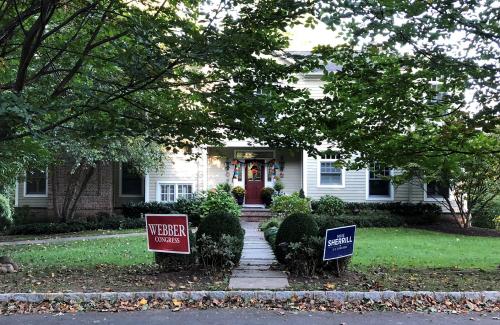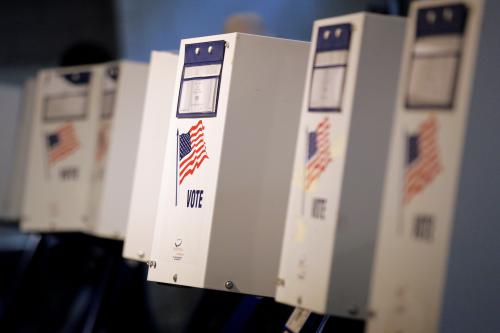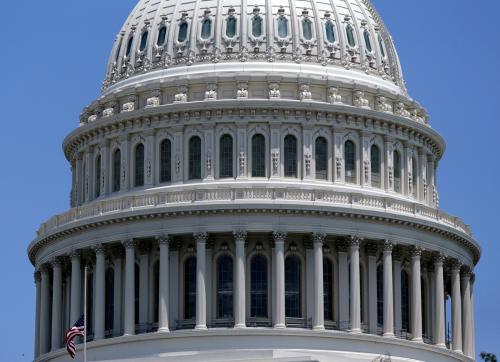Congressional candidates filed their six-month financial reports with the Federal Election Commission (FEC) on July 15. But the one number that leapt off the page had little to do with finance. It immediately made me think about wave elections.
The candidates were raising money, of course—especially the incumbents. (Detailed six-month tables for 2003-2017 are available at this link.) Yet, we should not to make too much of the receipts at this stage. The typical winner in House elections spends about $1.5 million, so there is still a lot of fundraising left, and plenty of time to do it.
Strong beginning
The numbers that stood out were for the challengers. Molly Reynolds wrote an earlier piece about the importance of candidate recruitment. The FEC filings confirm those early accounts, and then some.
As of the end of June, 209 Democratic challengers had registered with the FEC and raised at least $5,000. That more than doubled the previous high mark since 2003. In 2009, the Republicans had 78 challengers with at least $5,000. The early GOP challengers in 2009 foreshadowed the party’s regaining majority control. The question is whether the same will hold true for the Democrats in 2018.
 The number of challengers at six months is truly remarkable. And the candidates are not simply bunching up in a few primaries. Yes, there is some doubling up: six Democrats have filed so far against John Faso in New York’s 19th congressional district. But there is also a good spread. So far, 105 different Republican incumbents have Democratic challengers with $5,000. At this same time in 2009, only 50 of the Democratic incumbents were up against challengers with $5,000.
The number of challengers at six months is truly remarkable. And the candidates are not simply bunching up in a few primaries. Yes, there is some doubling up: six Democrats have filed so far against John Faso in New York’s 19th congressional district. But there is also a good spread. So far, 105 different Republican incumbents have Democratic challengers with $5,000. At this same time in 2009, only 50 of the Democratic incumbents were up against challengers with $5,000.
So the Democrats are putting themselves in a strong position to take advantage of a national tide in their direction, if there is one. This is important. No matter how strong a tide may be nationally, congressional elections are decided in districts. The party riding a wave cannot win in a district unless it puts up a credible candidate. You cannot beat somebody with nobody. Finding a credible candidate has to come first.
Don’t count your chickens
But winning the first inning is not the same as winning the ninth. For one thing, we have not looked at the challengers’ political backgrounds. For another, the campaign finance world after Citizens United is unpredictable. As of June 30, the number of Democratic challengers was up but their average receipts were down. Even so, the big campaign finance story for 2018 will not be foreseen through the candidates’ early receipts. One year from now, potential donors will have a better idea of which challengers look strong, which incumbents look vulnerable, and which open seat contests may be susceptible to a party switch. Democrats will have one strong financial advantage on their side. Millions of donors gave to Bernie Sanders (and other candidates) through ActBlue and other Internet-based intermediaries. These same donors will be drawn back to the same platforms and new ones. With the donors’ attention focused on control of the Congress, many of them will give, and give again.
Consider the special election in the 6th district of Georgia on June 20. As of May 31, Democratic candidate Jon Ossoff had raised about $23 million. More than $15 million was “unitemized,” meaning that the contributions fell below the $201 threshold for disclosure. Among the disclosed contributions, $1.1 million came from California – $269,000 more than from Georgia. This was a nationalized campaign that drew the attention of Democratic donors who were reacting to President Trump. Most competitive challengers in 2018 will not raise as much as Ossoff, but they will draw from the same well.
However, the special election in Georgia also has another post-Citizens United story to tell. After all, Ossoff lost. Karen Handel, the winner, raised less than $500,000 in the first round election on April 18. She raised another $4 million between the two rounds. But at least as important financially was the $13.2 million in independent expenditures (IEs) by the National Republican Congressional Committee and the Congressional Leadership Fund, a Super PAC allied with the House Republican leadership. The bottom line lesson for future races: if the contest looks close and is seen to have national significance, then the money will be there in abundance on both sides.
Georgia-6 may be extreme, but it is a telling example with parallels. As reported in a Campaign Finance Institute study earlier this year, in the 34 competitive House races with at least $2 million in IEs in 2016, the IEs outpaced candidate money by 1.3 to 1. The formal party committees and two major party leadership Super PACs were responsible for 88 percent of those IEs. In the Senate, where control of the chamber was at stake, eight states accounted for 92 percent of all general election IEs. In those states, the IEs outpaced candidate money by nearly 2 to 1. The formal party committees and two major party leadership Super PACs accounted for 65 percent of the IEs.
We can expect more of the same in 2018, with one important difference. With no Presidential race, donors who have money and who care will be focused on Congress. If the massive enrollment by challengers translates into viable campaigns, the autumn of 2018 may be an election season to remember.
Michael J. Malbin is co-founder and Executive Director of the Campaign Finance Institute, a nonpartisan research institute based in Washington DC. He is also Professor of Political Science at the University at Albany, SUNY.






Commentary
Does the opening predict a wave?
July 24, 2017